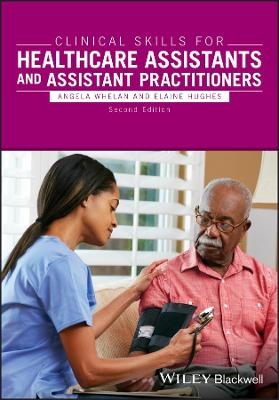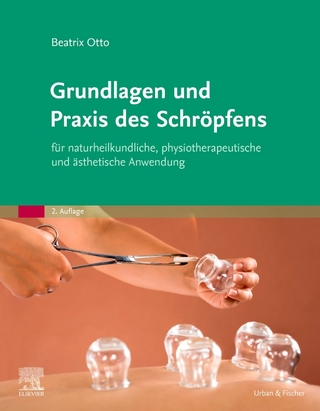
Clinical Skills for Healthcare Assistants and Assistant Practitioners
Wiley-Blackwell (Verlag)
978-1-118-25641-1 (ISBN)
Fully updated in its second edition, this book is divided into three sections; the first looks at fundamental skills applicable to all staff, such as accountability, communication and record keeping. Section two explores core clinical skills such as respiratory care, pulse, blood glucose management and catheter care. Section three outlines complex clinical skills that require more in-depth training, such as medication and intravenous cannulation.
An invaluable resource for healthcare assistants and assistant practitioners, this book will also be of use to newly qualified practitioners, and students in health and social care.
Angela Whelan is a Senior Lecturer, Teaching and Learning Fellow, and Programme Lead, in the Faculty of Health and Social Care at Edge Hill University, UK. Elaine Hughes is a Senior Lecturer in Adult Nursing, Deputy Programme Co-ordinator BSc(Hons), and a SOLSTICE Fellow, in the Faculty of Health at Edge Hill University, UK.
Preface xi
Acknowledgements xiii
Introduction xv
Section I: Fundamental skills
1 Accountability 3
Aim of this chapter 3
Regulation and registration 3
Healthcare assistants and assistant practitioners 4
Responsibilities and accountability 5
Delegation 8
Related aspects and terminology 10
Summary 16
References 17
2 Communication in healthcare 19
Aim of this chapter 19
Why good communication is important 19
Definition of communication 20
Communication methods 22
Strategies to improve communication 27
Related aspects and terminology 27
Common problems or communication barriers 29
Skills for the Health Care Certificate 31
Summary 31
References 32
Addendum 33
3 Psychological well-being 34
Aim of this chapter 34
What is meant by psychological care? 34
Psychological assessment in the healthcare setting 35
The importance of psychological care in the healthcare setting 37
Strategies to optimise psychological well-being 41
Pharmacological (drug-related) options 43
Non-pharmacological options 44
Therapeutic sense of self 44
Common problems 45
Summary 46
References 47
4 Documentation and record keeping 49
Aim of this chapter 49
The importance and purpose of documentation in relation to clinical skills 49
Confidentiality in records and documentation 52
Types of documentation 52
Legal aspects relating to documentation 53
Common problems 56
Related aspects and terminology 56
Strategies to improve standards of record keeping 56
Summary 57
References 59
Section II: Core clinical skills
5 Pulse 63
Aim of this chapter 63
What is a pulse? 63
Relevant anatomy and physiology 64
Related aspects and terminology 66
Factors affecting the pulse rate 67
Terminology 68
Automated devices 70
Fetal heartbeat 73
Documentation 75
Common problems 76
Summary 79
References 80
6 Blood pressure monitoring 81
Aim of this chapter 81
What is blood pressure? 81
Reasons for monitoring blood pressure 81
Who requests the test? 81
Who can take a BP reading? 82
What is done with the readings/information? 82
Relevant anatomy and physiology 82
Related aspects and terminology 86
Terminology 87
Korotkoff’s sounds 88
Equipment 89
Sites for recording blood pressure 93
Taking blood pressure 94
Documentation 96
Common problems 96
Summary 102
References 103
7 Temperature 105
Aim of this chapter 105
What is temperature? 105
Reasons for measuring temperature 105
Normal limits 106
Relevant anatomy and physiology 107
Related aspects and terminology 107
Terminology 113
Taking a temperature reading 116
Route 119
Taking a temperature reading 119
Documentation 121
Common problems 124
Summary 125
References 128
8 Pulse oximetry 130
Aim of this chapter 130
What is an oxygen saturation reading? 130
Who can perform the test? 130
Reasons for recording an oxygen saturation level 131
Relevant anatomy and physiology 132
Related aspects and terminology 132
The mechanics of pulse oximetry 132
Equipment 134
Normal readings 134
Using a pulse oximeter 136
Documentation 137
Common problems 137
Summary 141
References 142
9 Respiratory care 143
Aim of this chapter 143
What is respiratory care? 143
Relevant anatomy and physiology 144
Upper respiratory system 144
Lower respiratory system 145
Recording a respiratory rate 147
How to measure and record a respiratory rate accurately 151
Measuring and recording a peak expiratory flow rate 151
Performing suctioning 154
Related aspects and terminology 156
Common problems 157
Summary 158
References 162
Addendum 163
Reference 166
10 Urinalysis and faecal occult blood testing 167
Aim of this chapter 167
Reasons for performing urinalysis and FOB tests 167
Relevant anatomy and physiology 168
Urinalysis testing 170
Faecal occult blood testing 175
Related aspects and terminology 178
Common problems 178
Summary 179
References 183
Addendum 183
11 Urinary catheterisation and catheter care 185
Aim of this chapter 185
Urinary catheterisation 185
Relevant anatomy and physiology 186
Types of catheterisation 188
Patient preparation for catheterisation 193
Insertion technique 194
Catheter care 198
Sampling 199
Removal of catheter 200
Related aspects and terminology 208
Terminology 210
Common problems 210
Summary 210
References 212
12 Venepuncture 214
Aim of this chapter 214
Reasons for performing venepuncture 214
Relevant anatomy and physiology 214
Common sites for venepuncture 215
Infection 215
Hand hygiene 218
Aseptic (sterile) technique 219
Health and safety 219
Environment 220
Performing the skill: requirements and technique 220
Related aspects and terminology 227
Common problems 229
Summary 232
References 233
13 Blood glucose monitoring 235
Aim of this chapter 235
What causes diabetes? 235
Reasons for performing blood glucose measurement 235
Relevant anatomy and physiology 236
Related aspects and terminology 237
Blood glucose levels 241
Hypoglycaemia 247
Hyperglycaemia 248
Common problems 249
Summary 251
References 254
14 Fluid balance and intravenous maintenance 256
Aim of this chapter 256
Reasons for monitoring fluid balance 256
Related anatomy and physiology 256
Electrolytes 258
Related aspects and terminology 259
Fluid balance charts 261
The intravenous route 263
Care of the cannula 267
Discontinuing an IV infusion 267
Common problems 268
Summary 269
References 273
Section III: Complex clinical skills
15 Medicines 277
Aim of this chapter 277
The role of healthcare assistants and assistant practitioners in relation to medicine administration 277
Types of medicines 278
Medication prescribing and legal aspects 279
Related aspects and terminology 281
Common medications 286
Errors in administration and adverse reactions 291
Summary 292
References 292
16 Peripheral intravenous cannulation 294
Aim of this chapter 294
Reasons for cannulation 294
Why perform peripheral IV cannulation 295
Relevant anatomy and physiology 295
How to insert and remove a peripheral IV cannula 296
Environment 301
Performing peripheral IV cannula: requirements and technique 301
Patient education for peripheral IV cannulation 303
Related aspects and terminology 308
Common problems/potential complications of peripheral IV cannulation 309
Summary 314
References 317
17 Recording a 12-lead Electrocardiograph (ECG) 319
Aim of this chapter 319
Relevant anatomy and physiology 320
The cardiac conduction system 320
Reasons for recording a 12-lead ECG 322
How to perform a 12-lead ECG 323
Related aspects and terminology 330
Common problems and actions 331
Summary 332
References 335
Index 337
| Erscheinungsdatum | 28.05.2016 |
|---|---|
| Verlagsort | Hoboken |
| Sprache | englisch |
| Maße | 170 x 244 mm |
| Gewicht | 694 g |
| Themenwelt | Sachbuch/Ratgeber ► Gesundheit / Leben / Psychologie |
| Medizin / Pharmazie ► Medizinische Fachgebiete | |
| Medizin / Pharmazie ► Pflege | |
| ISBN-10 | 1-118-25641-7 / 1118256417 |
| ISBN-13 | 978-1-118-25641-1 / 9781118256411 |
| Zustand | Neuware |
| Haben Sie eine Frage zum Produkt? |
aus dem Bereich


